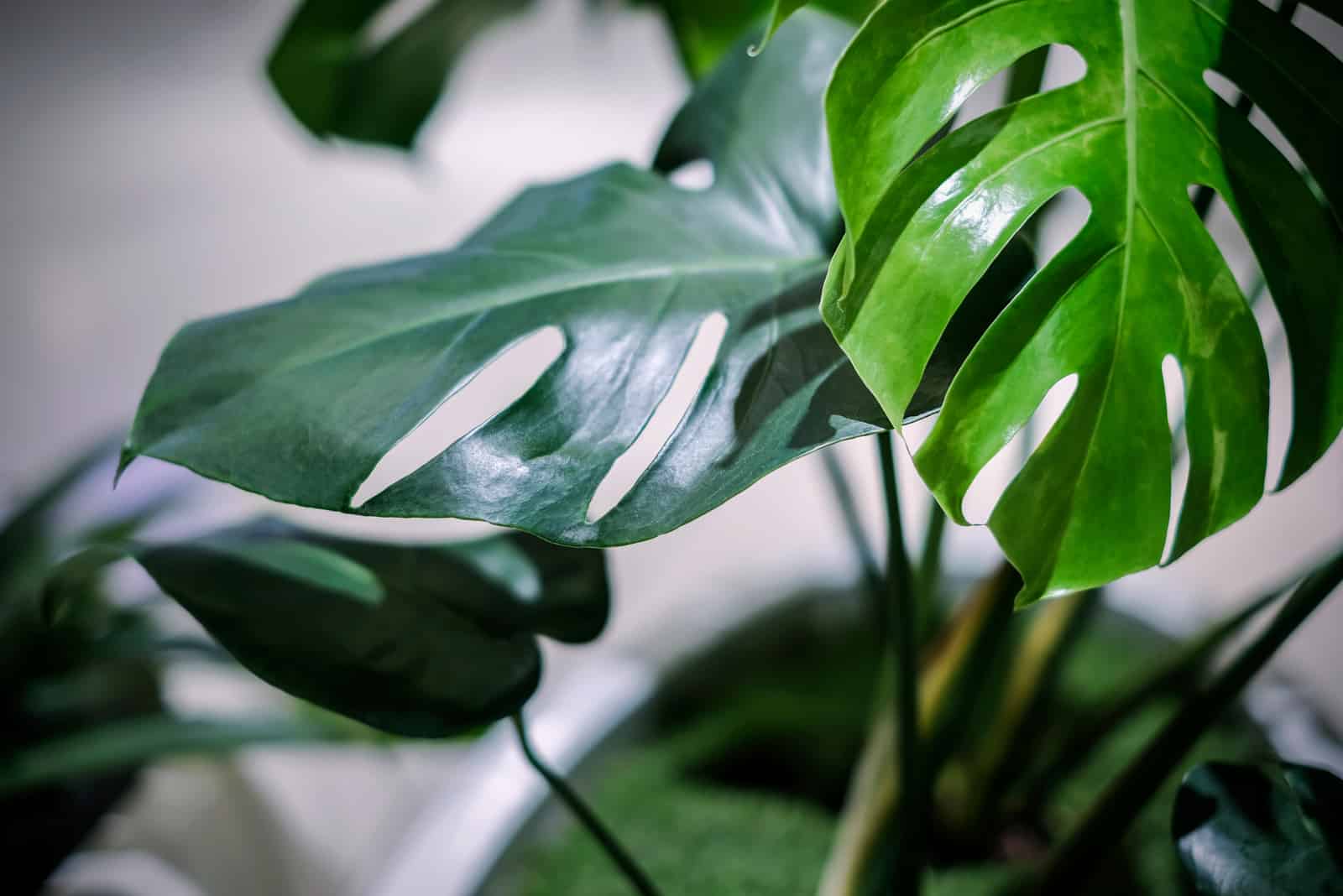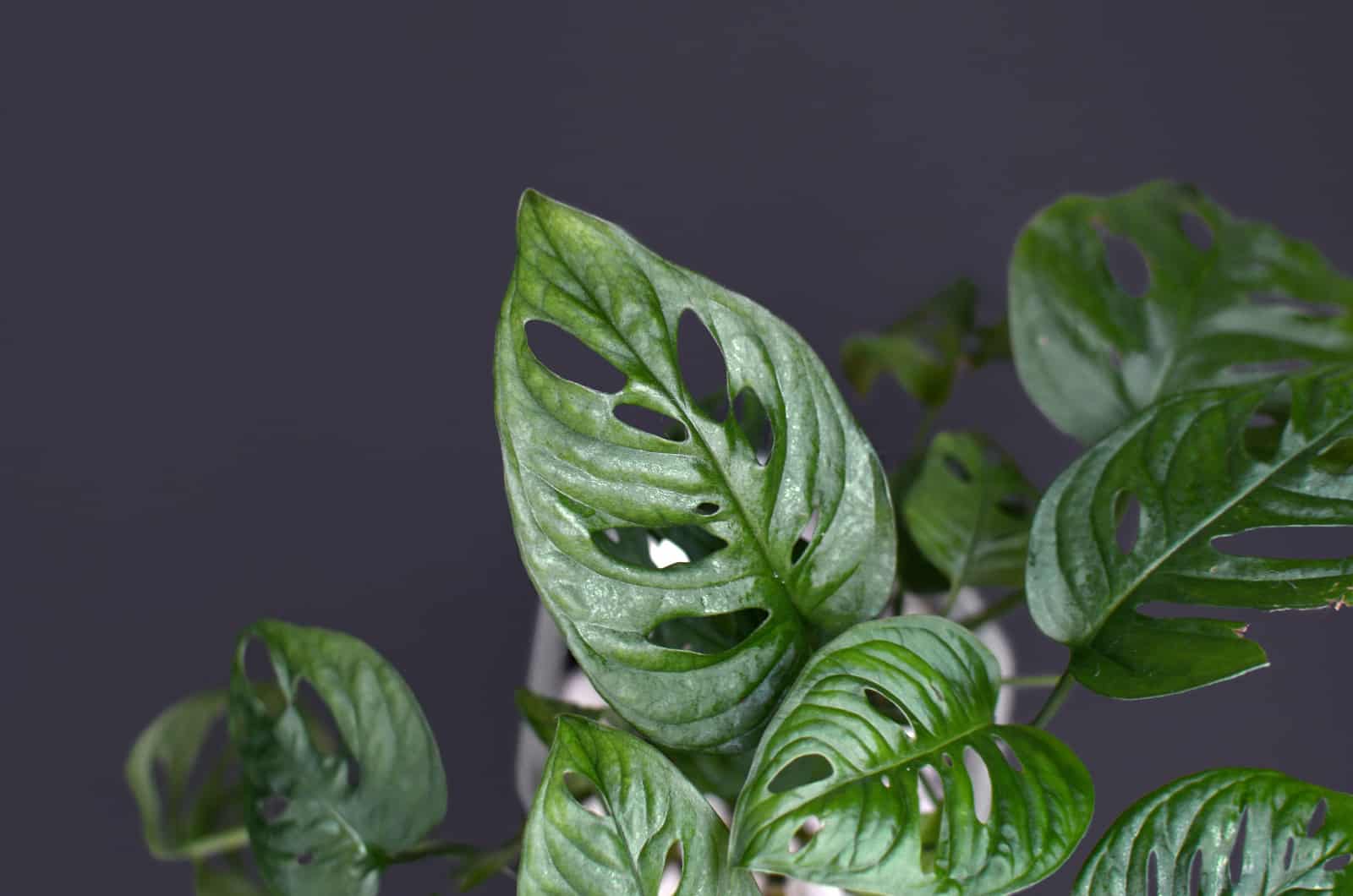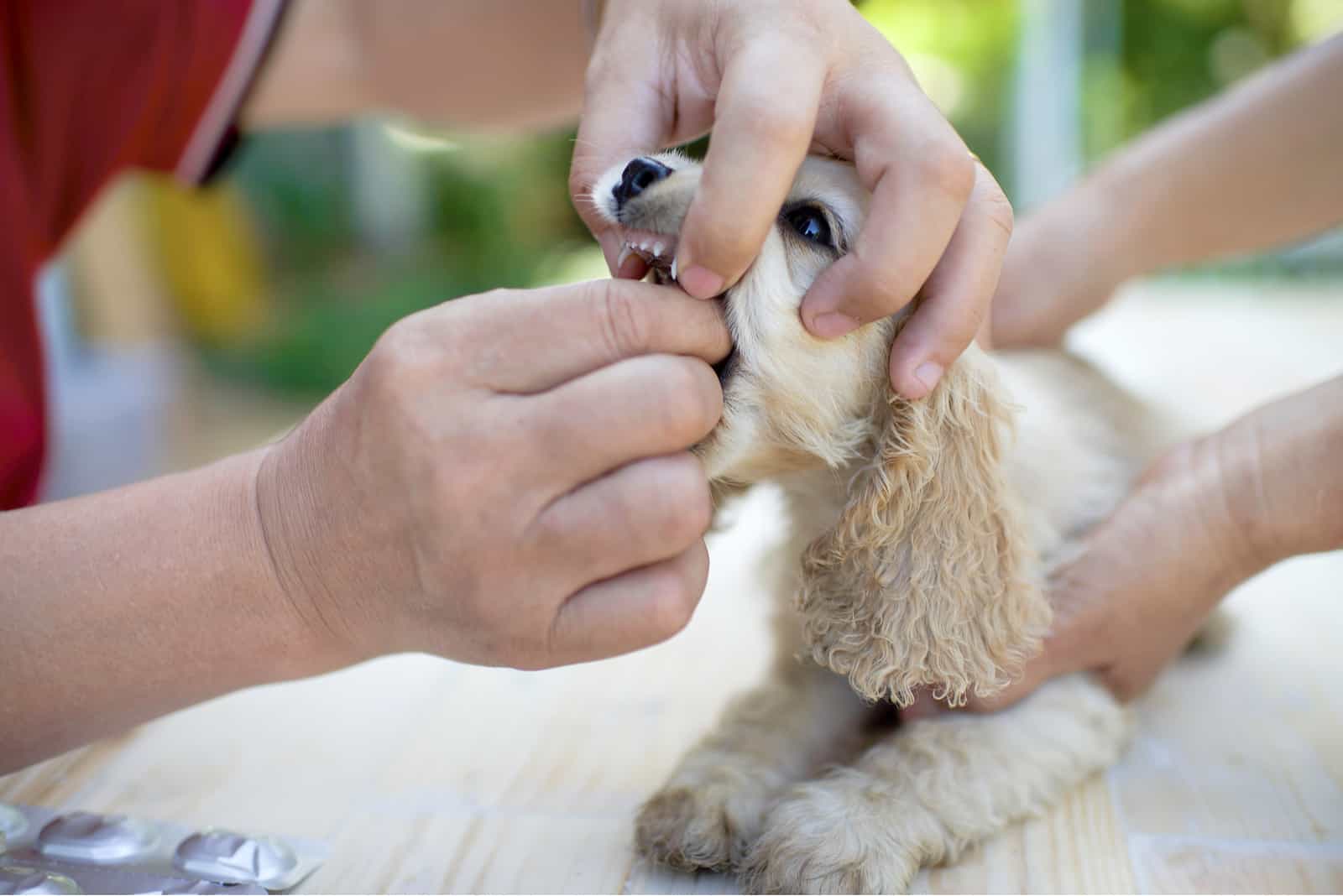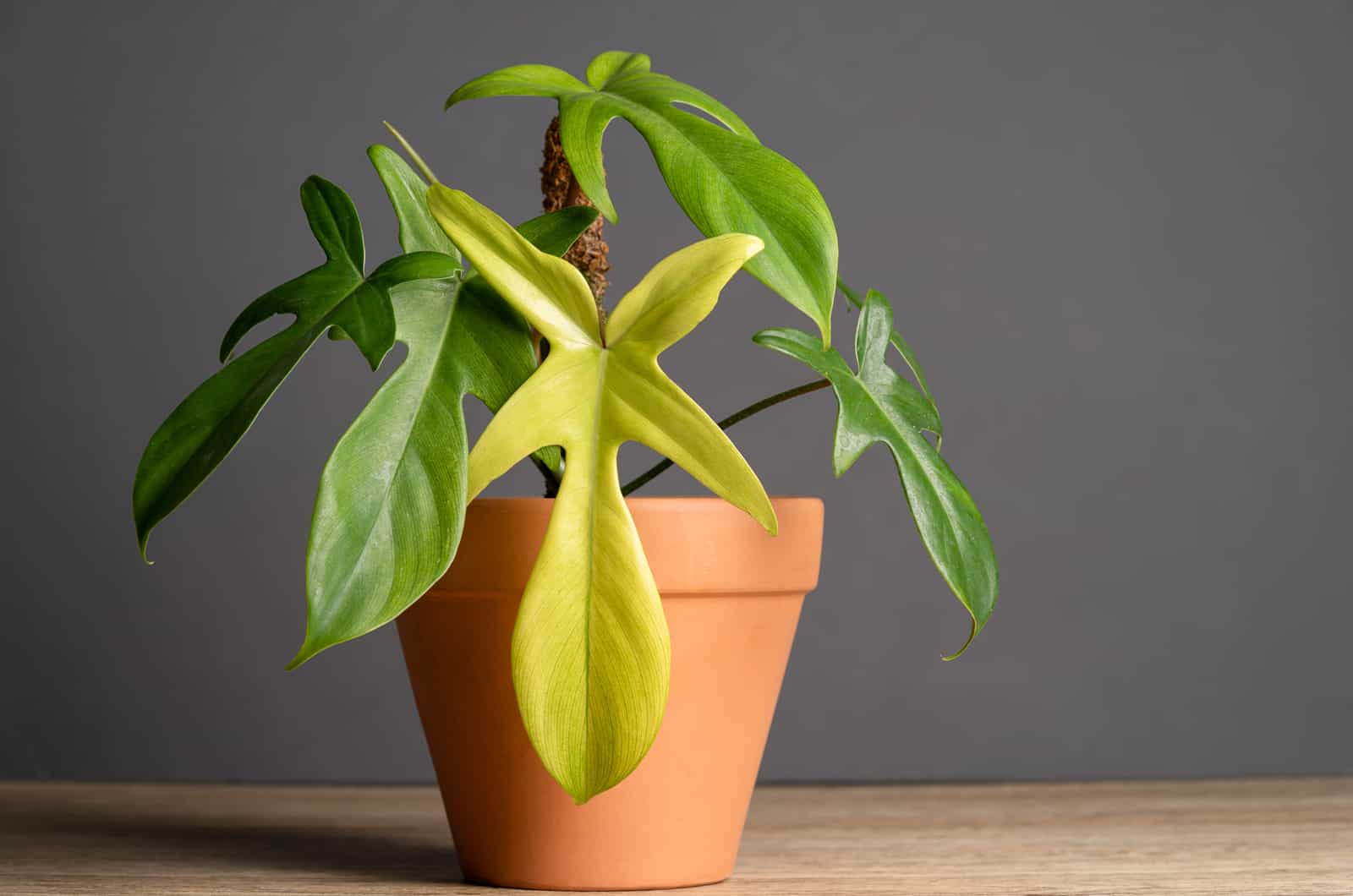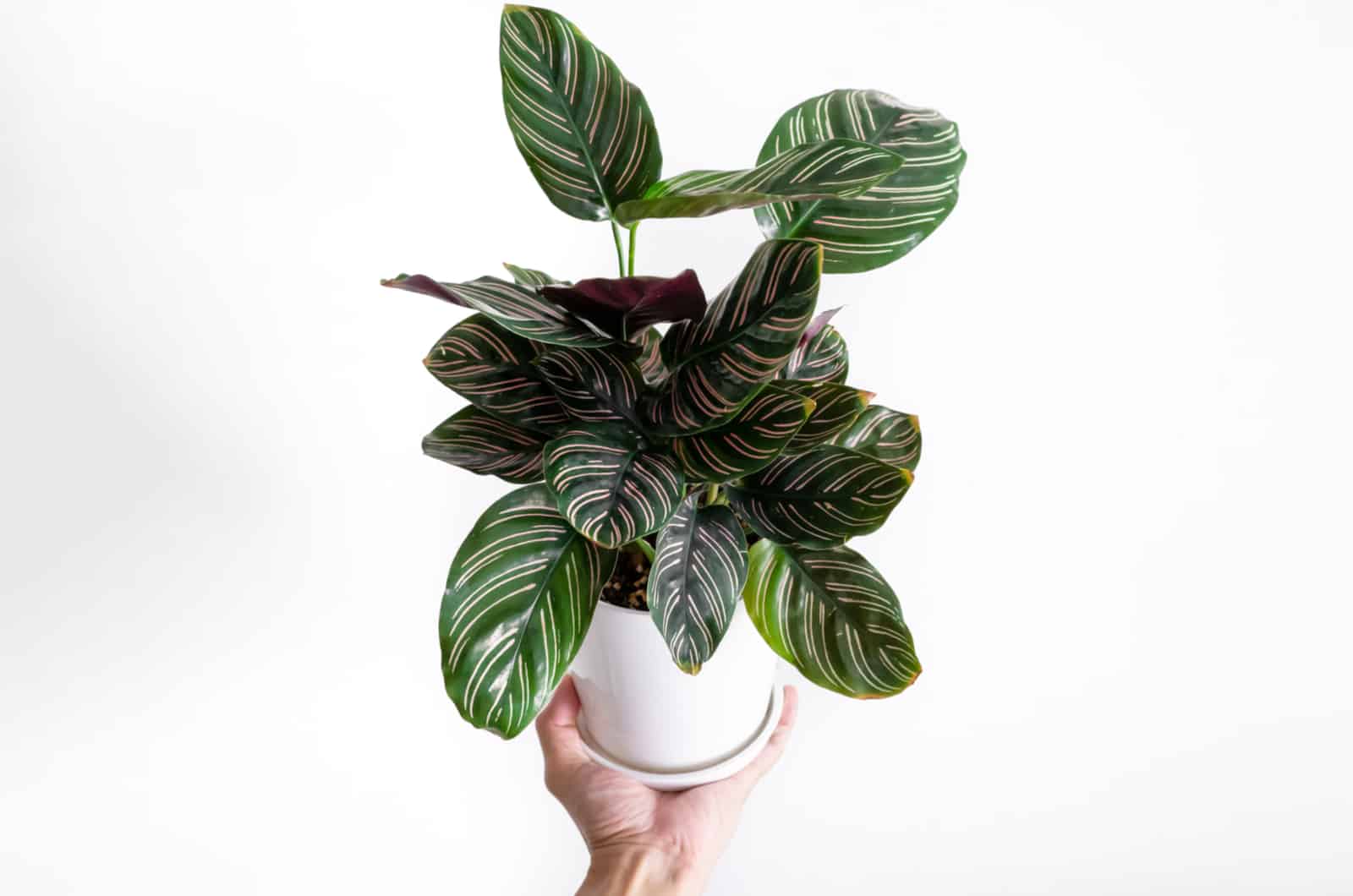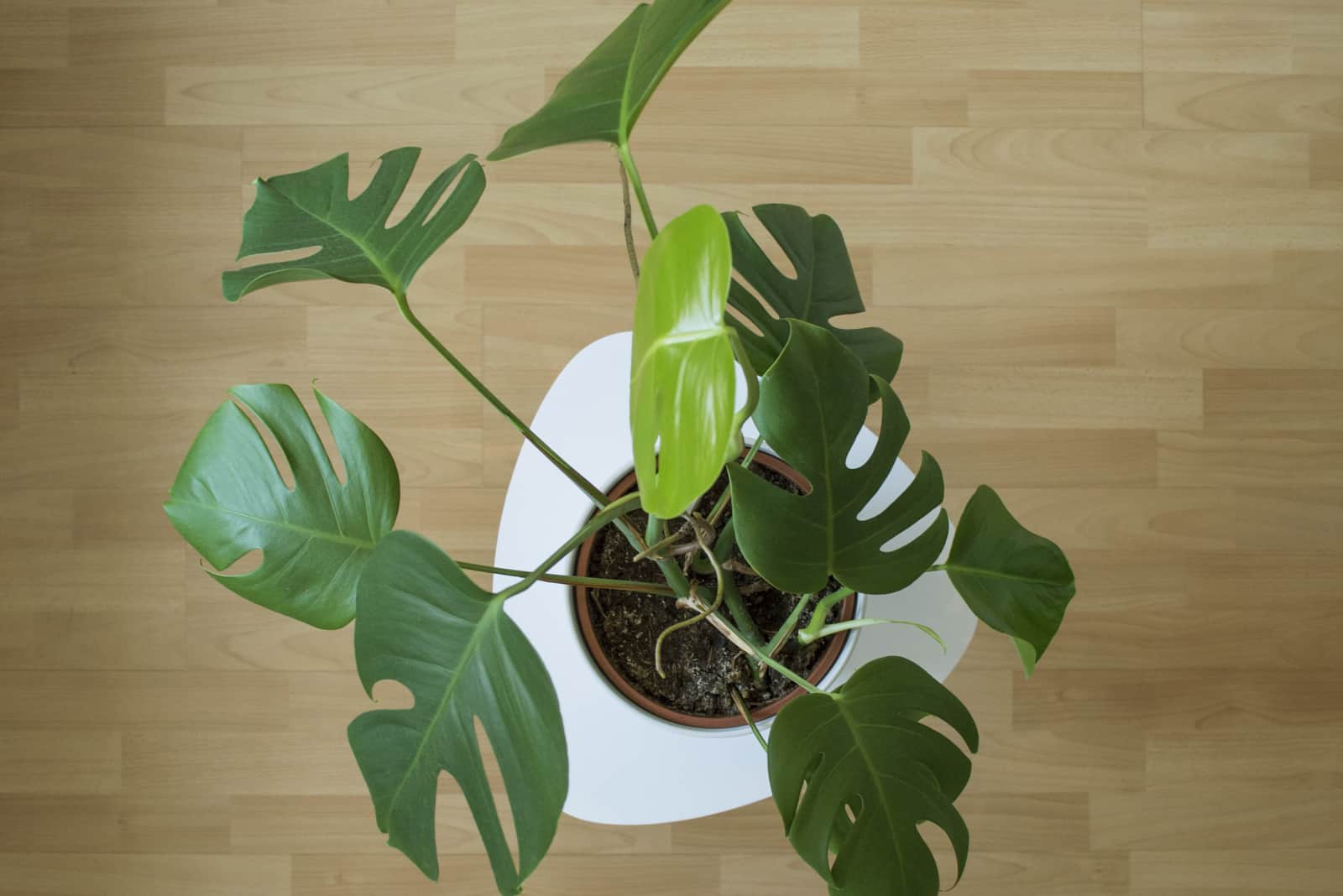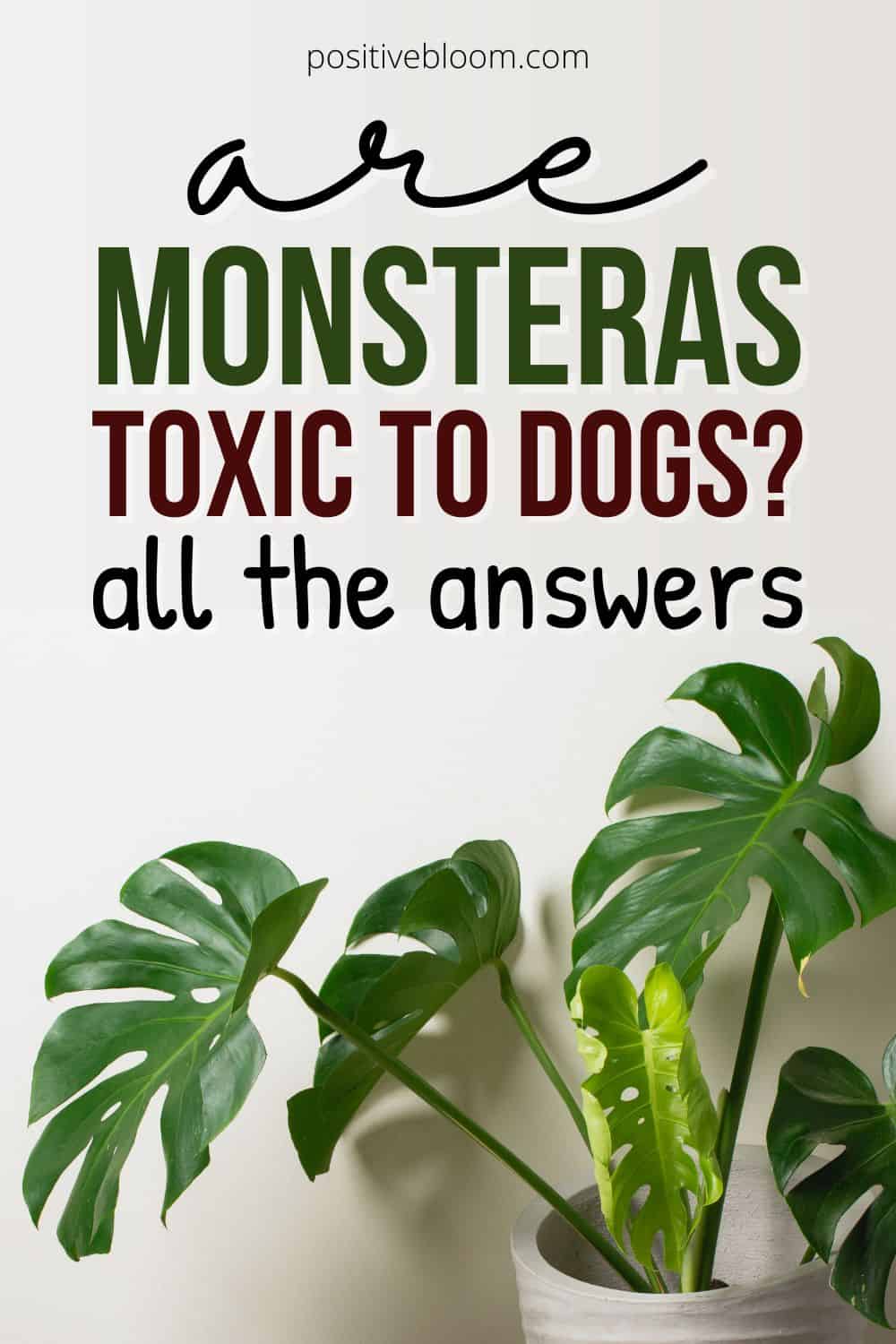When we are choosing plants for our homes, we mainly consider their appearance and size.
However, if you have curious toddlers or pets at home, you must also consider their toxicity!
Monsteras are great for first houseplants because they are easy to take care of and look stunning.
If you own a dog, you might be wondering, ‘are Monsteras toxic to dogs?
We’re going to answer that question and more right here, so let’s get started!
Are Monsteras Toxic To Dogs?
The answer to this question is YES! Plants from the Monstera genus, such as Monstera deliciosa or Monstera adansonii, are toxic to dogs according to ASPCA research!
You might be wondering why Monsteras are such common indoor plants considering how many people have dogs at home.
The thing is that these plants won’t instantly kill your dog, but they can cause issues, especially if your canine friend ingests a lot of the plant.
It’s essential to know why Monsteras are toxic, which parts of it cause the issues, and the symptoms of poisoning, so that you can start treating it.
Of course, the best thing would be to prevent this from happening in the first place, so I’ll also show you some methods for that.
First, let’s find out what causes toxicity in Monsteras!
Why Are Monstera Plants Toxic?
It’s essential to know why Monstera plants are toxic, and the reason they are poisonous plants are the calcium oxalate crystals they contain.
Calcium oxalate, a biomineral found in plants, appears as crystals in various forms. It is a substance that exists in all plant tissues and organs. It is frequently generated in the vacuoles of specific cells known as crystal idioblasts.
According to recent research, the production of calcium oxalate generally functions as a mechanism for controlling the levels of calcium in tissues and organs. However, a number of additional functionalities might have developed incidentally.
These crystals are insoluble, and if you observe them under the microscope you’ll see they are located in raphides. Raphides are defined as collections of needle-shaped crystals.
If the plant comes into contact with saliva it releases the crystals, and that’s when the problems arise. Your dog won’t die immediately after ingesting this plant, but it will certainly feel some consequences.
These crystals can cause kidney stones, but the reason plants create them is not fully understood.
What Parts Of The Monstera Plant Are Toxic To Dogs?
Stems, leaves, and even the roots of Monstera are toxic to dogs! Why? All these parts of the plant contain the calcium oxalate crystals we discussed above. The crystals can be found anywhere sap blossoms.
First, let’s discuss the stems. Stems are longer plant sections, and the sap runs through them to reach the leaves and roots.
Therefore, ingesting any part of the stem is dangerous for your dog. I recommend wearing gloves when handling the stem, especially if you decide to propagate your Monstera cuttings in water.
The leaves are another extremely poisonous part of the Swiss cheese plant. You should be extra careful with the leaves as they are what your dog is most likely to ingest first.
Dogs tend to dig in pot soil, so it’s not uncommon for them to ingest the roots, and the roots of Monstera plants are also toxic.
Monsteras produce fruit, which is the only non-toxic part of the plant. However, this refers only to ripe fruit, as unripe fruit contains calcium oxalate crystals.
Symptoms Of Monstera Poisoning
It’s essential to learn how to recognize Monstera poisoning in dogs.
One of the first reactions to poisoning is a burning sensation in the dog’s mouth. If your dog doesn’t want to eat anything you offer and starts whining, it may have been nibbling on Monstera leaves.
Another symptom is excessive drooling. If your dog is producing more saliva than usual, check if there are any traces of biting on your Monstera.
Your canine friend may also have difficulty swallowing. Dogs will lean their heads to one side or throw their heads back if they have ingested any Monstera.
Monstera poisoning also causes stomach irritation. Your dog will completely lose its appetite, have diarrhea, and start vomiting in this case.
If your dog repeatedly paws at its snout, it may be a result of eating a part of your Monstera plant.
Another symptom is oral irritation, which causes the lips, tongue, and mouth of your furry friend to swell.
How Much Does Swiss Cheese Plant Toxicity Affect Dogs?
I mentioned that this plant wouldn’t kill your dog immediately after ingestion, however, the severity of the consequences depends on a few factors.
First, your dog’s overall health; the healthier the dog, the fewer symptoms it will show.
If your dog already has a weak immune system, it will show more signs and may suffer more significant complications.
The second thing is the dog’s age. Of course, older dogs will have more issues as a result of poisoning as it will be harder to cure them.
The last thing is the dog’s size. Smaller dogs may suffer from more severe poisoning, but remember that it won’t kill them, so don’t panic immediately!
How To Treat Monstera Poisoning
Now that we know the answer to the question, “Is Monstera toxic to dogs?”, it’s time to find out what to do if your dog eats part of the Monstera plant.
Most dog owners will probably panic if they think their dog has ingested something poisonous.
The first thing you should do is contact a vet. I also suggest you contact the Pet Poison Helpline on (855) 764-7661, or the Animal Poison Control Center (ASPCA).
Typically, your veterinarian will advise some secure home therapies. You can clean the dog’s mouth and remove the remaining parts of the plant. Make sure you wash the dog’s mouth with fresh water.
The next thing you can do is induce vomiting. I also suggest using hydrogen peroxide at this point, just make sure it hasn’t been opened or is past its expiration date.
Your dog can also drink some milk or water, but don’t leave them alone, not even for a second.
I always say, a friend in need is a friend indeed!
Should You Visit The Vet?
If you’re still in doubt, you can go to the vet. Of course, if your dog doesn’t show any signs of improvement, visiting the vet is a must!
You should take a section of the plant your dog ingested. Alternatively, take a picture of your Monstera plant and show it to the vet.
The vet will check the respiratory system, blood pressure, pulse, and temperature.
If the vet is unsure about the poisoning, they will most likely perform an endoscopy after sedating your dog.
Sometimes additional tests are performed, such as urinalysis or fecal examination.
Don’t worry, your dog is in safe hands!
When Will The Dog Recover?
This depends on the severity of toxicity, in other words, how badly it affected the dog. If there are any complications, your dog might have to spend a night or two in the clinic until the vets are sure everything is fine.
I must mention a few things about the dog’s behavior when it returns from the vet because your paw friend will definitely need some time to recover fully.
Your dog may also lose its appetite and reject its favorite food, but it won’t last for long; in a day or two you’ll see them eating just as before.
You can also offer them food like boiled chicken or turkey as it’s easier for them to digest.
What Is The Best Way To Keep A Dog From Eating A Monstera?
Experienced gardeners always suggest growing these popular houseplants as they are easy to care for and look fascinating. Gardeners who are also pet owners sometimes don’t pay attention to toxicity, however.
The ones that do also pay attention to how to keep their dogs from eating these plants.
Here are a couple of methods you can use to keep your dog safe!
Keep Your Monstera Deliciosa Out Of Reach
The best idea would be to place your Monstera somewhere your dog can’t reach. The great thing is that Monstera plants can be grown in hanging baskets, so they’ll look amazing on shelves high up on a wall.
Some pet and plant-lovers make special places for either the pets or plants. Many also wonder if Monsteras are toxic to cats.
You can fence off a corner in your house so that all your plants are grouped, which is also great for raising humidity levels. Remember that the fence needs to be strong, especially if you own a big dog.
Another option is to have a special room in your household for plants only. Of course, this is best for bigger homes. So, grab a chair, add some bookshelves and your favorite books, and then place your plants all around you!
Train Your Canine Friend
Dogs are clever and patient animals. This method can seem pretty hard in the beginning, but it’s the best way to keep your dog – and your plants – safe.
The good old ‘treat’ method will work in this case. Prepare a couple of snacks your dog likes, and every time the dog moves away from your Monstera, give it a treat.
Continue doing this until your little pals understand that they will receive a small reward or treat if they stay away from the Monstera plant.
Use Deterrents
Dogs aren’t fans of citrus fruits, so you can use sprays based on lemon or orange to keep your dog away from your Monstera leaves.
Vinegar and cayenne pepper are two more ingredients dogs don’t really like, so try spraying vinegar or sprinkling cayenne pepper over your Monstera.
The great thing is that none of these things affect Monsteras, so it’s safe for both plants and dogs!
You can also try growing plants with spiky leaves and placing them around your Monsteras or any other plants.
Distract The Dog
You can also try distracting your dog using their favorite toys!
Chew, squeaky, or stuffed dog toys will undoubtedly keep your dog distracted from wanting to be nibbling on your Monstera plants.
It may also keep your furniture safe as an added bonus!
Other Toxic Houseplants
Unfortunately, Monsteras aren’t the only toxic plants dangerous to dogs. Many plant species and varieties also contain insoluble calcium oxalate crystals that are toxic to dogs.
Let’s look at some other popular houseplants that you need to be careful about if you own a dog!
Philodendron
According to the ASPCA, all plants from the Philodendron genus, including the popular Split-leaf Philodendron or Philodendron gloriosum, are toxic to dogs.
If your dog suffers from Philodendron poisoning, it will show symptoms such as drooling, vomiting, difficulty swallowing, and loss of appetite.
Remember that Philodendrons are trendy houseplants, so be careful when visiting plant loving friends with your dog.
Jade Plants
Jade plants belong to the Crassulaceae family and contain toxins that can cause many health issues for your dog.
Although jade plant poisoning may only cause modest symptoms like a slight stomach ache, some veterinary experts have said that it can also result in more severe problems.
Some noted symptoms include drooling, skin irritation, vomiting, slower heart rate, lethargy, and muscular movement problems.
It has to be mentioned that these symptoms rarely occur, and even if they do, your dog will quickly recover.
Alocasia
Alocasias, also known as Elephant ear plants, can also be toxic to dogs.
Alocasia poisoning manifests itself immediately as difficulty breathing and swallowing, loss of appetite, and mouth swelling. Be careful and react immediately if your dog ingests any part of the Alocasia as it can kill it!!!
In addition, the toxic substances found in Alocasia leaves and stems are extremely dangerous to dogs’ eyes and skin.
Aloe
Aloe is another common indoor plant that’s toxic to dogs. Anthraquinone glycosides are found in these plants, which boost mucus production and water in the colon when ingested.
The most common symptoms of Aloe poisoning are vomiting and diarrhea, but weight loss or depression may also occur.
Peace Lily
Every part of the peace lily plant, including the stems, leaves, and even the showy blossoms, contain toxins that can be harmful to your furry friend.
Although peace lily poisoning isn’t fatal, it can be pretty distressing to dogs when ingested.
If your dog licks its fur or paws after touching the plant, it can result in skin irritation.
Dieffenbachia
Dieffenbachias are popular indoor plants, but they are also frequently grown outside as attractive shrubs or bushes.
Unfortunately, these plants are also toxic to dogs as they contain calcium oxalate crystals, as well as some other acids and enzymes harmful to canines.
Although eye exposure is uncommon, it can be excruciatingly painful, so you should visit the vet immediately if it gets in your dog’s eyes.
If your dog has Dieffenbachia poisoning, it will show symptoms such as coughing, mouth or face swelling, drooling, vomiting, and skin irritation.
Snake Plants
Snake plants are popular houseplants due to their striking looks and ease of maintenance. However, they are also toxic to dogs and can cause dizziness, vomiting, and diarrhea if ingested according to the ASPCA.
If you suspect your dog has consumed any part of a snake plant, you should call your vet straight away.
Poisoning won’t result in death if your dog only ingests small quantities, but if it’s half of the plant or more, take your dog to the vet as soon as possible.
Pothos
Most dogs who suffer from pothos poisoning recover successfully with only supportive treatments. However, if you put off getting veterinary care for too long, crystal formation in the urinary tract could cause other health problems.
But remember that the chances of a full, quick recovery are increased the earlier you seek veterinary care.
ZZ Plant
ZZ plants look amazing and also have other intriguing characteristics, such as filtering toxins from the air. These are the reasons this plant is so frequently seen in plant collections.
However, the ZZ plant is toxic to your dog, and even though it won’t cause severe complications compared to other toxic houseplants, you’ll need to be extra careful with this plant.
If your dog ingests any part of the ZZ plant, you might notice drooling, diarrhea, or loss of appetite.
Dog-safe Houseplants
If all of that seemed a little scary, never fear, because there are plenty of stunning non-toxic plants that you can grow!
The most popular dog-friendly plants are prayer plants, Calathea, Peperomias, spider plants, and zebra plants.
Let’s find out more!
Prayer Plants
Prayer plants are a perfect addition to a large, mixed pot as their luxuriant foliage complement other houseplants. Additionally, prayer plants purify the air in your house by removing toxins.
Prayer plants are considered hardy plants, are colorful, and they thrive in all kinds of lighting (except direct sunlight).
If we add the fact that they are pet-safe plants, there’s no reason not to grow them!
Calathea
Lots of low-maintenance and dog-friendly plants come from the Calathea genus.
As well as these characteristics, Calatheas look fascinating and make outstanding ornamental plants.
They are also air-purifiers and stress relievers.
So, if you want a plant that will decorate your space, clean the air, grow well with a bit of neglect, and is dog-friendly, Calathea is the perfect choice!
Peperomia Plants
If you are looking for a beautiful Feng Shui plant that brings wealth and health to your home, you should grow a Peperomia!
That’s not the only great thing about this plant, it’s also non-toxic to dogs, purifies the air, looks incredible, and is easy to grow.
And that’s not all! You can quickly get many more Peperomias using any part of this plant for propagation. How remarkable!
Spider Plants
The Spider plant is especially well-liked by beginners because it is simple to grow and propagate, forgiving, and able to thrive in almost any environment.
So, if you are a beginner plant grower and you own a dog, consider getting a spider plant.
The breathtaking variegated green and creamy leaves will leave anyone speechless and, luckily, not poisoned!
FAQs
Are Monsteras toxic to humans?
All plants from the Monstera genus are toxic to humans! Monstera poisoning in humans results in issues with the digestive system, including nausea, difficulty swallowing and speaking, and mouth or throat swelling.
Please wear gloves when handling this plant, and never prune, propagate, or repot it without them!
Also make sure to keep your toddlers away from Monstera plants!
What is the most toxic plant to dogs?
The most toxic plant to dogs is Cycas Revoluta, also known as Sago palm. All parts of this plant are toxic, including the seeds, so make sure it’s always kept out of reach of pets or is protected in some way.
Poisoning manifests in vomiting, thirst, blood coagulation issues, liver failure, and even death if left untreated.
Why do dogs eat houseplants?
Dogs actually find many decorative house plants quite delicious, so be careful when choosing your indoor plants.
Typically, dogs chew on grass to make them vomit, which helps them feel better, but if you see that they are vomiting a lot you should take them to the vet for a checkup.
If your dog is experiencing gas, it will likely try to alleviate the unpleasant feelings they are experiencing. They ingest certain plants to induce constipation or vomiting, which will help them relieve their gastric discomfort.
Dogs can frequently feel bored and start looking for activities, which can lead to them consuming foliage to pass the time. Give your dog lots of engaging toys, you can find loads of great ones on Amazon.
Wrapping Up
Plant care is great stress relief, so it’s no wonder it’s becoming more and more popular.
Dogs are man’s best friend, so if you are a dog owner and a plant lover, specifically a Monstera lover, it’s not surprising you wanted to find out the answer to Are Monsteras toxic to dogs?
Now that you know the answer, you should be careful with growing Monstera plants, especially if you have very curious furry friends.
Luckily, there are methods that can keep your dog from eating your Monstera plants, so try using them to make a safe environment for both your dogs and Monstera plants.
Until next time!
Like this post? Share or pin it for later!

